

You are using an out of date browser. It may not display this or other websites correctly.
You should upgrade or use an alternative browser.
You should upgrade or use an alternative browser.
Skully
PMA Member
Well going on two weeks of no rain since I put my rye, oats, peas and clover in.
Hope we get some soon. No growth except a few clover after 7 days.
Come on rain.
Was it Skully that did the raindance last time?
It may have been me but I need to pour some concrete this weekend so no rain dance until Sunday!!! :grin:
One note I wanted to add was a little tip for anyone who is thinking of planting Milo or grain sorghum next year. I planted mine WAY too thick! It is hard to judge with a broadcast spreader and I always tend to "over-seed" a little for safe measure but in this case it was a mistake. My old clay knob was in CRP before planting and could have used a shot of nitrogen but I went the cheap route and now my milo plot is about half the height it should be and is very yellow from being under nourished. It is still a thick mess and I'm sure wildlife will use it but I learn something new every time I play farmer. Next time I will use a drill!
dbltree
Super Moderator
could have used a shot of nitrogen
Remember to start using a crop rotation that uses clover before high nitrogen users like brassicas, corn or milo to lower nitrogen inputs.
This combination planted this fall will help with a portion of you nitrogen needs next year.
Winter rye 50-80#'s per acre (56#'s = a bushel)
Spring oats 80-120#'s per acre (32#'s = a bushel)
Austrian Winter Peas 20-40#'s per acre (4010 or 6040 field peas will work fine for 1/2 the price)
Red Clover 8-12#'s per acre
Oilseed Radish 5#'s per acre
The good thing about milo is that it can be planted late which allows more time for the red clover to fix more nitrogen. Hairy vetch will also work to add nitrogen and is available from Welter Seed as well.
I haven't had a drop of rain either...
dbltree
Super Moderator
PAul,
I asssume it nothing has germinated yet that it will be okay.
Unless the turkeys eat it all.
Sure...the seed will just lay there waiting for moisture but don't assume it hasn't germinated! We had plenty of subsurface moisture so seeds planted in a good seedbed and covered/packed properly are still likely to germinate anytime now.
A 1/2" of rain would certainly speed up the process however....
dbltree
Super Moderator
Most of us haven't had a rain since planting our cereal grains and peas which gives cause for concern and a good time to bring up the questions "what is the proper planting depth for cereals??"
While I don't advocate planting wheat for deer and food plot rotations, wheat is of course the most commonly grown cereal grain in the world and so a great deal of study has been done on proper planting rates and depths for optimum yields.
This link gives one some basic data to use when planting any cereal grains:
Small Grain Seeding Rates
The gist of it is answered here:
Lightly tilling or discing in broadcast grains before cultipacking insures a proper planting depth (note I said "light"... )
)
Peas can be even deeper at 1 1/2 to 3 inches deep.
Winter rye works great to broadcast on bare ground BUT we need rain to germinate the seed and followup rains to insure roots will grow deep enough to survive dry spells...
While I don't advocate planting wheat for deer and food plot rotations, wheat is of course the most commonly grown cereal grain in the world and so a great deal of study has been done on proper planting rates and depths for optimum yields.
This link gives one some basic data to use when planting any cereal grains:
Small Grain Seeding Rates
The gist of it is answered here:
reduce the chances of seedling emergence if the seeds are placed too deep. Conversely, a shallow planting can result in uneven germination due to dry soil.
Small grainseeds should be planted 1 to 1.5 inches deep when soil moisture levels are adequate, and slightly deeper, if moisture is deficient.
Oats should be planted at 2 bushels per acre, and rye at 1 to 1.5 bushels per acre. The seeding rate should be increased by 15 percent for every 2 weeks planting is delayed.
Lightly tilling or discing in broadcast grains before cultipacking insures a proper planting depth (note I said "light"...
Peas can be even deeper at 1 1/2 to 3 inches deep.
Winter rye works great to broadcast on bare ground BUT we need rain to germinate the seed and followup rains to insure roots will grow deep enough to survive dry spells...
dbltree
Super Moderator
I checked the "last planted first" to show kind of a worst case scenario and what might be expected. I tilled these small plots just to stir them up a little and left them because they were still a little wet at the time.
My intentions were to come back, re-till. plant, lightly till the larger seeds in and then sow the small seeds. Best layed plans however often go awry and after my tiller got in an argument with some stumps and...lost, I had only enough time to sow seeds in these roughly tilled but now dry plots and just packed them.
This means that some of the larger seeds didn't cover well, especially the peas which of course are no where deep enough and we have not had a drop of rain in over two weeks and certainly none since seeding.
Seeds germinated in the areas with a little moisture because they were at least pressed into the soil but some drier spots have yet to come up and may not until we get rain, something that is still at least a week away.
Peas should be 1-3" deep but many of course did not covered such as this pic shows
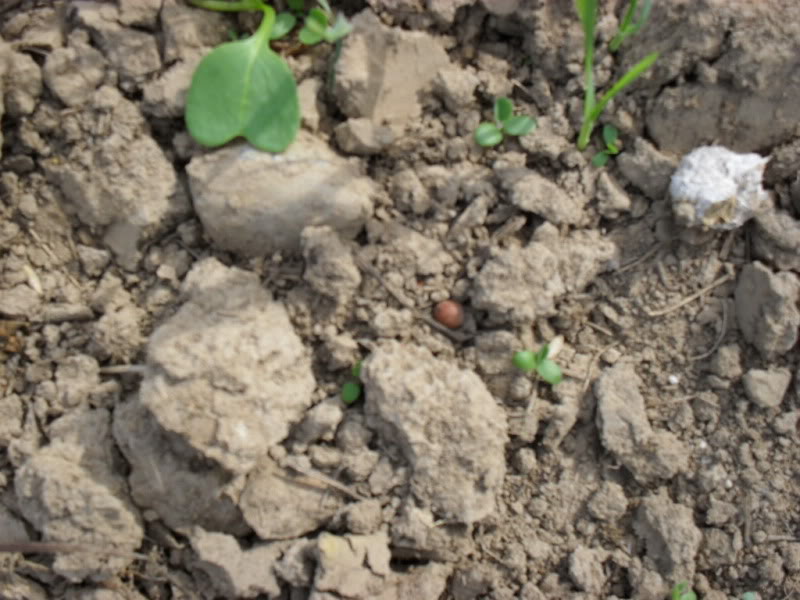
Any seed that did cover germinated and is growing despite the lack of rain
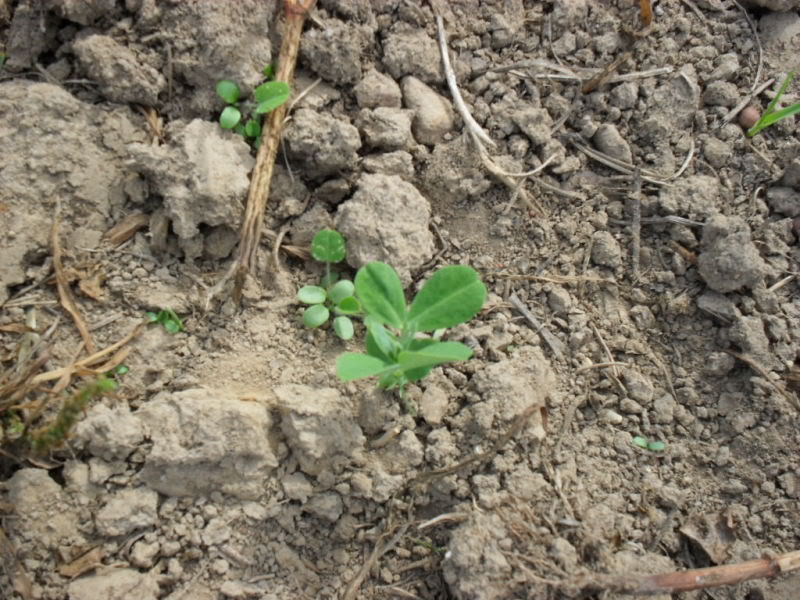
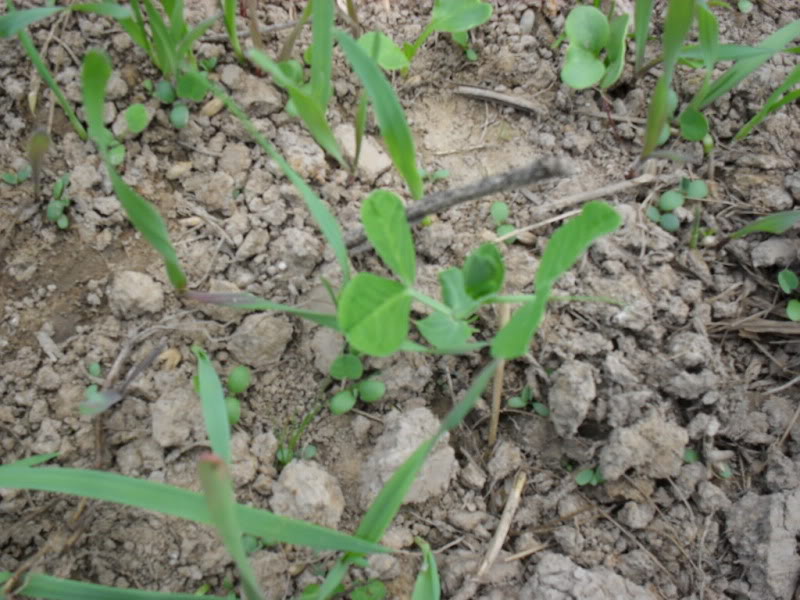
This plot was lower and had more moisture and it's greening up nicely
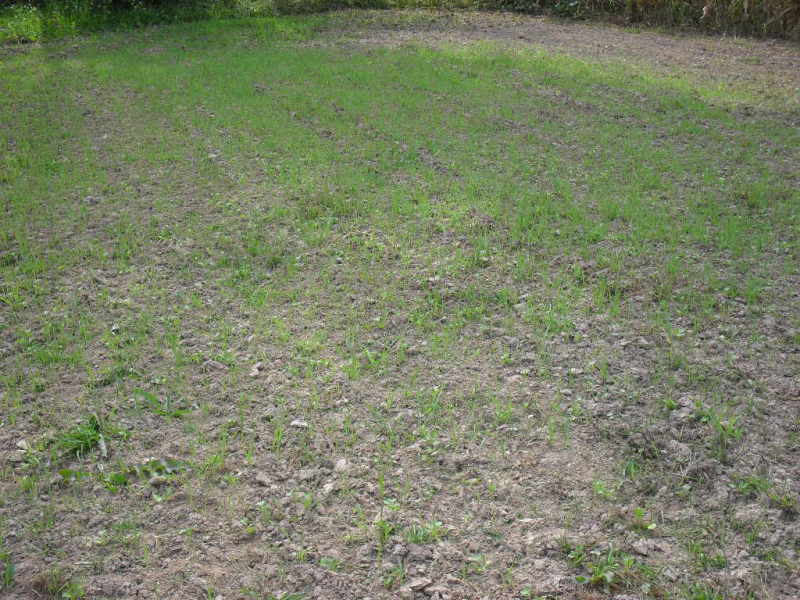
while this one only yards away but perhaps a foot higher is just starting to green up

You can pick out the rye amonsgst the oats by the reddish color of the rye near it's base
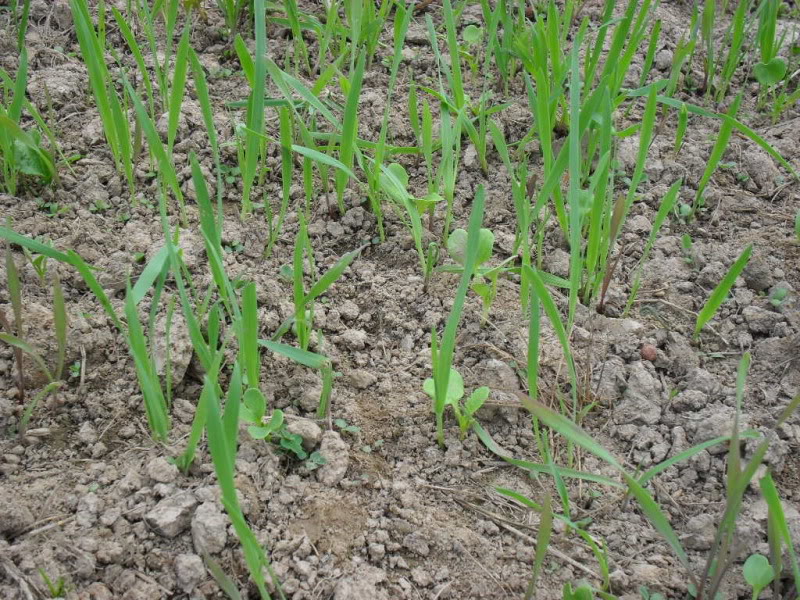
The Groundhog Forage Radish are coming up nicely and appear to need little moisture to germinate
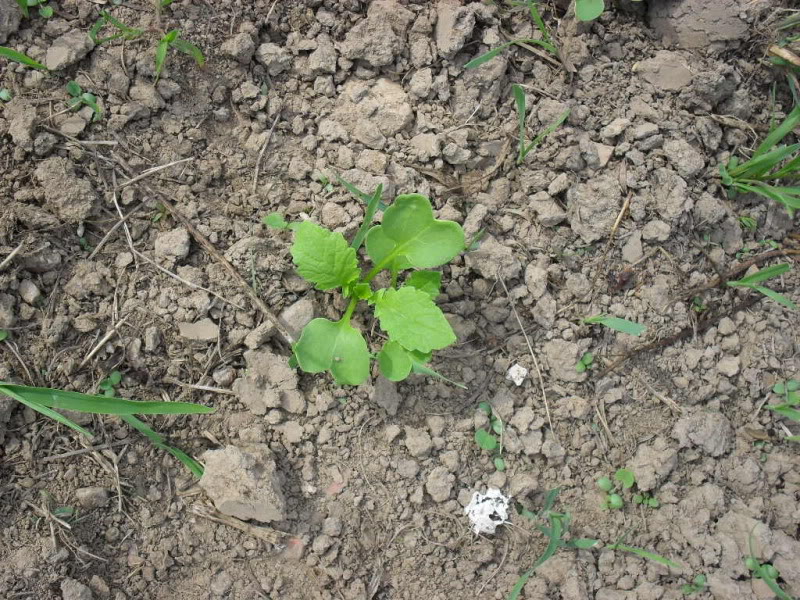
The red clover also germinating easily even in the drier areas
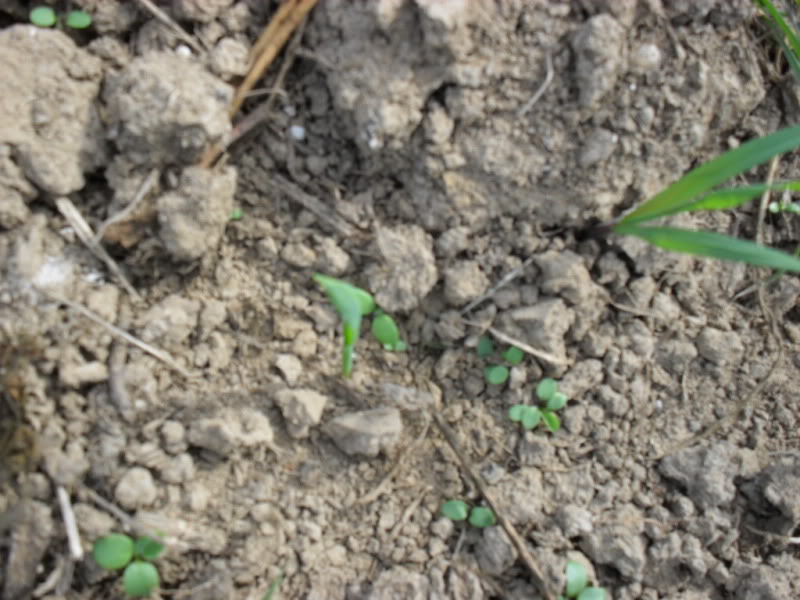
The rye and oats appear small right now but will grow rapidly over the next few weeks
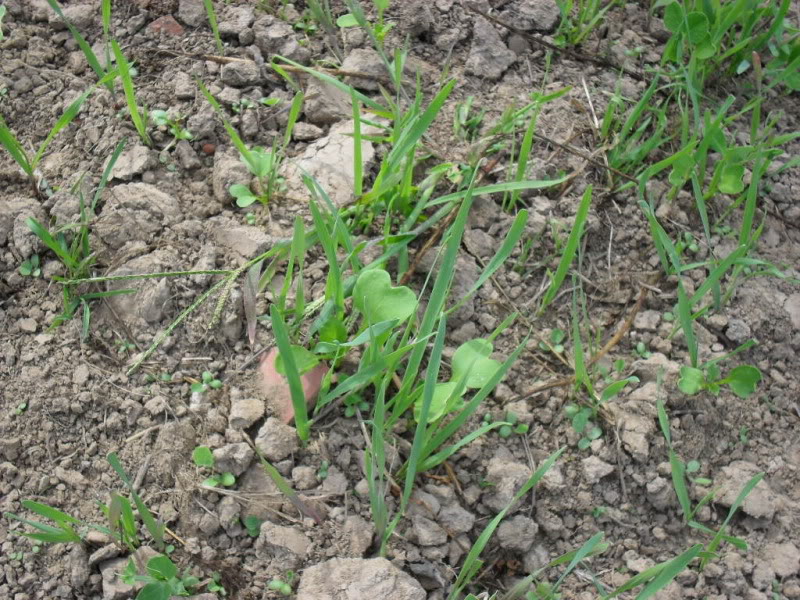
and already show evidence of grazing at less then 2 weeks after planting
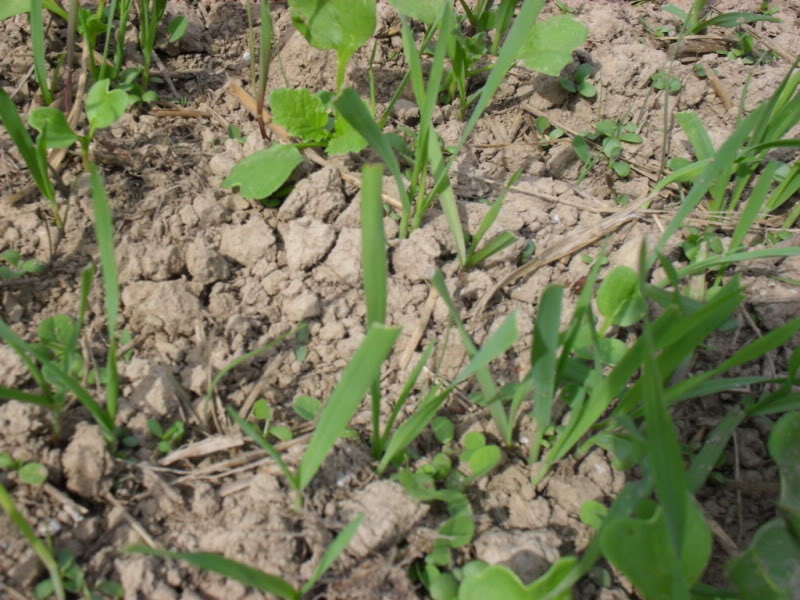
I share these pics to show that tilling larger seeds in can be important especially when we get an unexpected dry spell as it gets seeds down to subsurface moisture.
That even with out rains, seeds pressed into moist soils will still quickly germinate, that even grains planted as late as Oct in many midwest areas will still have time to provide a fall attractant.
I still have 200#'s or winter rye seed to broadcast into already standing crops but I'm waiting to do so ahead of a rain. Frosts have no effect on winter rye and it will germinate and grow even in the mid 30's so don't be afraid to try some late seedings if weather or time has held you up....
My intentions were to come back, re-till. plant, lightly till the larger seeds in and then sow the small seeds. Best layed plans however often go awry and after my tiller got in an argument with some stumps and...lost, I had only enough time to sow seeds in these roughly tilled but now dry plots and just packed them.
This means that some of the larger seeds didn't cover well, especially the peas which of course are no where deep enough and we have not had a drop of rain in over two weeks and certainly none since seeding.
Seeds germinated in the areas with a little moisture because they were at least pressed into the soil but some drier spots have yet to come up and may not until we get rain, something that is still at least a week away.
Peas should be 1-3" deep but many of course did not covered such as this pic shows

Any seed that did cover germinated and is growing despite the lack of rain


This plot was lower and had more moisture and it's greening up nicely

while this one only yards away but perhaps a foot higher is just starting to green up

You can pick out the rye amonsgst the oats by the reddish color of the rye near it's base

The Groundhog Forage Radish are coming up nicely and appear to need little moisture to germinate

The red clover also germinating easily even in the drier areas

The rye and oats appear small right now but will grow rapidly over the next few weeks

and already show evidence of grazing at less then 2 weeks after planting

I share these pics to show that tilling larger seeds in can be important especially when we get an unexpected dry spell as it gets seeds down to subsurface moisture.
That even with out rains, seeds pressed into moist soils will still quickly germinate, that even grains planted as late as Oct in many midwest areas will still have time to provide a fall attractant.
I still have 200#'s or winter rye seed to broadcast into already standing crops but I'm waiting to do so ahead of a rain. Frosts have no effect on winter rye and it will germinate and grow even in the mid 30's so don't be afraid to try some late seedings if weather or time has held you up....
Dbltree Mix

Here is Rye, Wheat, Oats, AWP and Red Clover Mix that I got in the last week in August.
Luckily had close to half inch of rain couple days after I got it in.
Used a drill that a farmer gave me and it worked good. Had it on the highest setting and only got about 88 lbs. of seed per acre. Next year I will zig zag the drill to get more seed on.
I then cultipacked after the drill and broadcasted red clover over the top and cultipacked again.
Red clover is coming up good also!
All the thanks goes out to Dbltree for all my food plots this year. Did about 10 acres of them and for the first year of doing food plots it was all Dbltree's advice and I couldn't be happier!
Thanks!
Cory

Here is Rye, Wheat, Oats, AWP and Red Clover Mix that I got in the last week in August.
Luckily had close to half inch of rain couple days after I got it in.
Used a drill that a farmer gave me and it worked good. Had it on the highest setting and only got about 88 lbs. of seed per acre. Next year I will zig zag the drill to get more seed on.
I then cultipacked after the drill and broadcasted red clover over the top and cultipacked again.
Red clover is coming up good also!
All the thanks goes out to Dbltree for all my food plots this year. Did about 10 acres of them and for the first year of doing food plots it was all Dbltree's advice and I couldn't be happier!
Thanks!
Cory
dbltree
Super Moderator
Luckily had close to half inch of rain couple days after I got it in.
You should've bought lotto tickey Cory...you must be one of the very few who got rained on!
Plost look great!! Keep us posted this fall!:way:
LoessHillsArcher
PMA Member
We got some rain out west!! That looks GREAT Cory!!
dbltree
Super Moderator
Many landowners don't know that winter rye is commonly broadcast into standing crops on a large scale by farmers with livestock, usually by airplane around the first of September.
They know that with any rain at all the rye will germinate on the bare soils and grow quickly, providing a high quality source of all winter grazing, high in crude protein and digestable nutrients as well as in yield of dry matter.
So as a habitat manager why wouldn't we take advantage of this and do the same thing? Soybeans are the easist to overseed with a hand seeder or a 3 pt spreader on a tractor but anything from thin brassicas to corn will work to over seed winter rye into.
The moment soybeans start to turn yellow is the time to broadcast rye and they will be dropping leaves within two weeks and allowing sunlight to the newly germinated rye.
A week earlier one could have been broadcasting rye into these beans
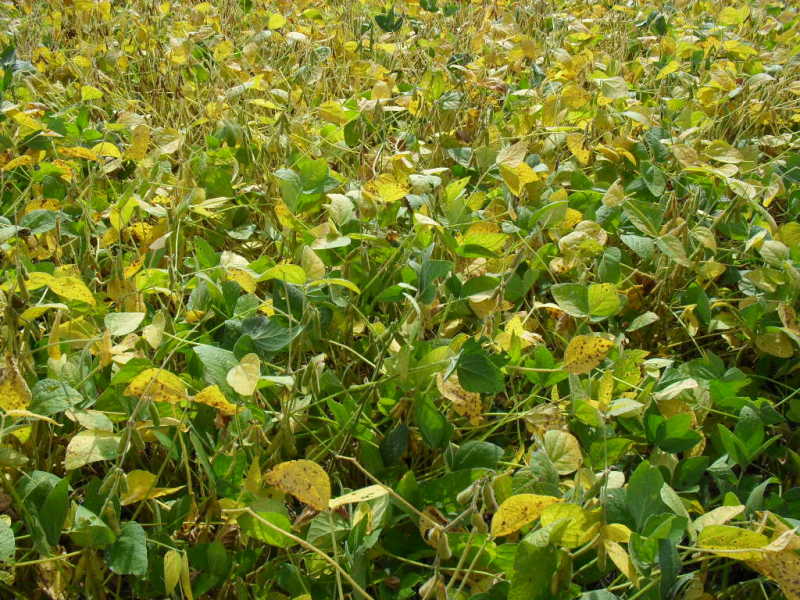
Closer inspection shows sunlight is already reaching the ground in these beans
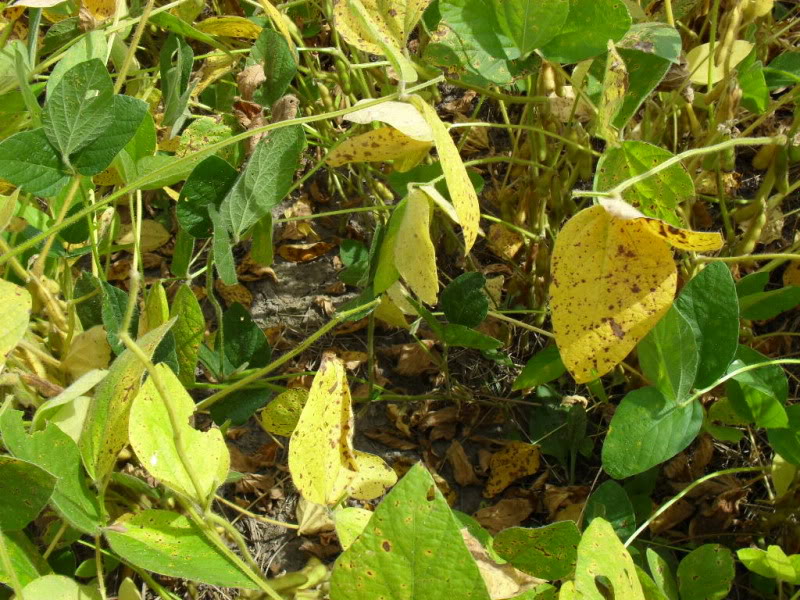
In normal years here in Iowa soybeans would be read to harvest by now but a very wet spring delayed harvest and many are still green and fully canopied.
I would point out here that for midwest and northern areas, this is the reason I prefer early maturing soybeans versus forage or late maturing soys.
I want beans to mature as early as possible so that rye and brassicas can be over seeded into them. The dried beans and the green rye and brassicas then provide an unbeatable combination that is capable of attracting deer literally all winter.
Late maturing beans such as forage beans stay green right up until frost at which point they become worthless right in the middle of hunting season and the late canopy makes it impossible to overseed rye into the stand.
Everyone has different needs and goals so this is something a landowner would need to decide for themselves.
Corn is more difficult to hand seed into because of it's height but it's still feasable and early maturing corn is already drying down here in mid September.
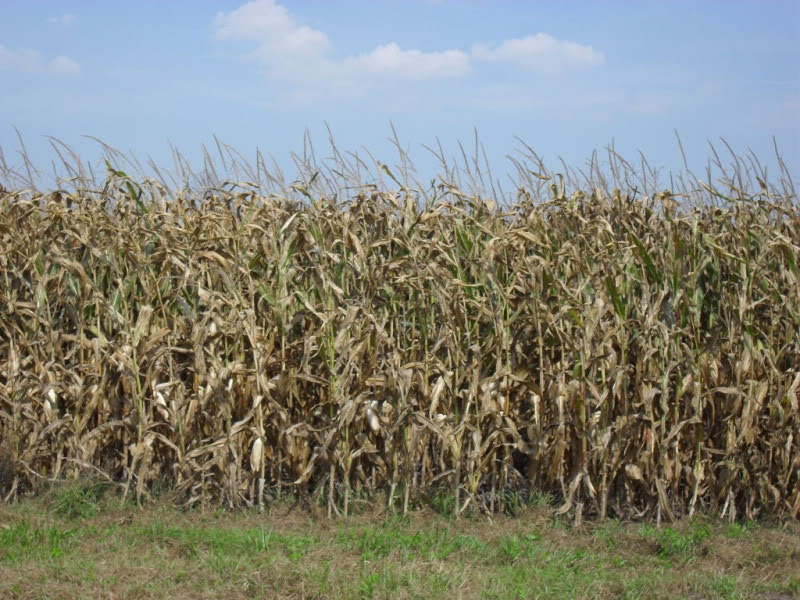
Again, the combination of standing corn and green rye growing in it would be extremely attractive and almost impossible to find something better.
I cannot grow either corn or soybeans in my plots and our commercially grown crops get chisel plowed but I'm going to try milo planted in wide rows and over seeding that wit rye this next year.
Winter rye germinates better then any other cereal grain when broadcast on bare ground but obviously moisture is needed. We are approcahing 3 weeks without rain here in SE Iowa so I have seed just waiting to broadcast into some decimated brassicas just before a rain when it eventually comes.
Broadcast winter rye at 150#'s per acre (rates are optional) because birds and rodents will get some before it germinates. The winter rye will scavenge nitrogen left from the current crops and recycle it the next spring not to mention helping to prevent the next weed crop from germinating and pulling potassium up from the subsoil also making that available for the next crop.
Take advantage of all the wonderful attributes of winter rye to not only attract deer and improve your soils but double the use of each acre you plant to soys and corn...
They know that with any rain at all the rye will germinate on the bare soils and grow quickly, providing a high quality source of all winter grazing, high in crude protein and digestable nutrients as well as in yield of dry matter.
So as a habitat manager why wouldn't we take advantage of this and do the same thing? Soybeans are the easist to overseed with a hand seeder or a 3 pt spreader on a tractor but anything from thin brassicas to corn will work to over seed winter rye into.
The moment soybeans start to turn yellow is the time to broadcast rye and they will be dropping leaves within two weeks and allowing sunlight to the newly germinated rye.
A week earlier one could have been broadcasting rye into these beans

Closer inspection shows sunlight is already reaching the ground in these beans

In normal years here in Iowa soybeans would be read to harvest by now but a very wet spring delayed harvest and many are still green and fully canopied.
I would point out here that for midwest and northern areas, this is the reason I prefer early maturing soybeans versus forage or late maturing soys.
I want beans to mature as early as possible so that rye and brassicas can be over seeded into them. The dried beans and the green rye and brassicas then provide an unbeatable combination that is capable of attracting deer literally all winter.
Late maturing beans such as forage beans stay green right up until frost at which point they become worthless right in the middle of hunting season and the late canopy makes it impossible to overseed rye into the stand.
Everyone has different needs and goals so this is something a landowner would need to decide for themselves.
Corn is more difficult to hand seed into because of it's height but it's still feasable and early maturing corn is already drying down here in mid September.

Again, the combination of standing corn and green rye growing in it would be extremely attractive and almost impossible to find something better.
I cannot grow either corn or soybeans in my plots and our commercially grown crops get chisel plowed but I'm going to try milo planted in wide rows and over seeding that wit rye this next year.
Winter rye germinates better then any other cereal grain when broadcast on bare ground but obviously moisture is needed. We are approcahing 3 weeks without rain here in SE Iowa so I have seed just waiting to broadcast into some decimated brassicas just before a rain when it eventually comes.
Broadcast winter rye at 150#'s per acre (rates are optional) because birds and rodents will get some before it germinates. The winter rye will scavenge nitrogen left from the current crops and recycle it the next spring not to mention helping to prevent the next weed crop from germinating and pulling potassium up from the subsoil also making that available for the next crop.
Take advantage of all the wonderful attributes of winter rye to not only attract deer and improve your soils but double the use of each acre you plant to soys and corn...
dbltree
Super Moderator
We have been nearly three weeks without rain but a cold front will be moving across much of the midwest from Sunday through most of next week as it stalls out over the heartland.
This gives us two much needed oppurtunities...
1) To overseed winter rye into standing, soybeans, corn or heavily grazed brassicas right before a rain that will insure germination and quick growth.
2) This is perfect timing to topdress nitrogen if you have any fall crops that need it. If you tilled in plenty of N at planting, it's doubtful that you will need aditional N. Now is the time however to watch the weather closely and apply urea as close as possible to rainfall that hopefully exceed a 1/2" to push nitrogen into the soil.
Winter rye is amazing in that it is one of the most drought resistant cereals and rye can grow on almost ANY soils from sand to clay with no lime or fertilizer. That doesn't mean you can't or shouldn't improve your soils by soil testing and applying the appropriate ammendments but it does mean that if you have a last minute plot you want to stir up and plant something...winter rye is the best bet!
Here are some pics of my rye and peas at 2 weeks despite not having a drop of rain...
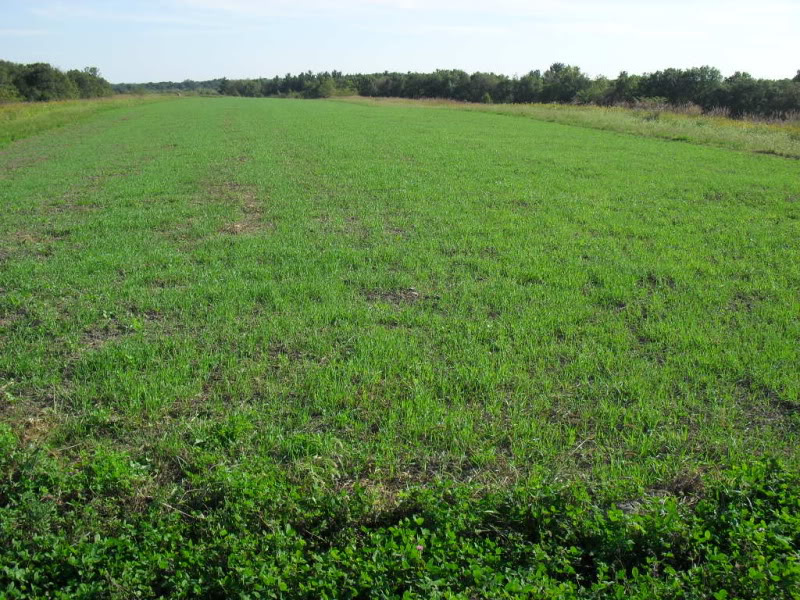
I lightly tilled in the larger seeds (winter rye, common oats, peas), cultipacked, sowed red clover and Groundhog Forage radish and re-cultipacked.
Because I put the larger seeds in the moisture zone of the soil, they are growing just fine even without rain.
I sowed two strips heavily and upped peas to nearly 100#'s per acre due to expected heavy deer traffic. I also added 150#'s of urea in these two test strips.
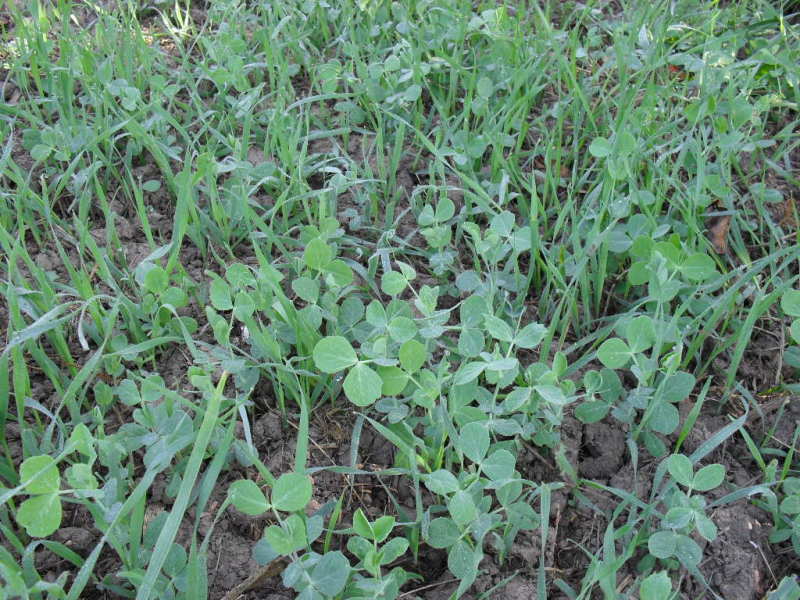
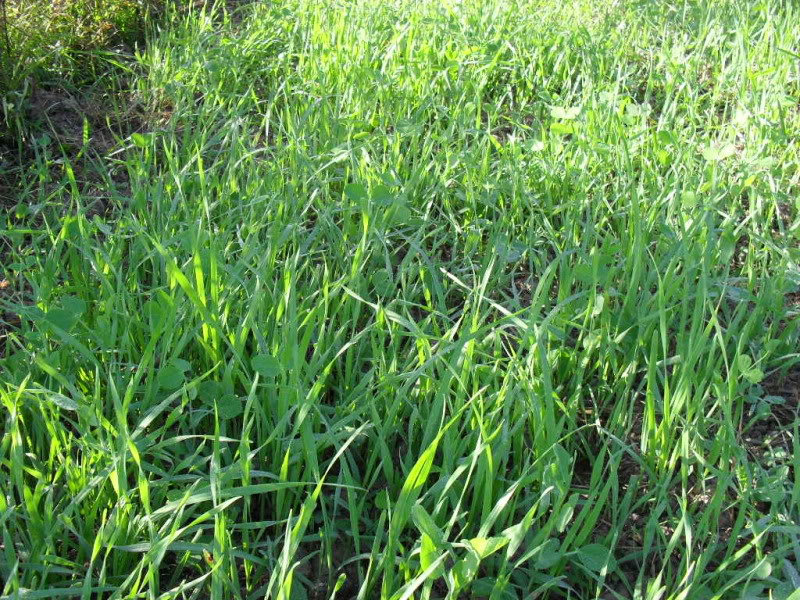
The two strips are in a tree planting, one with winter rye and Austrian Winter peas
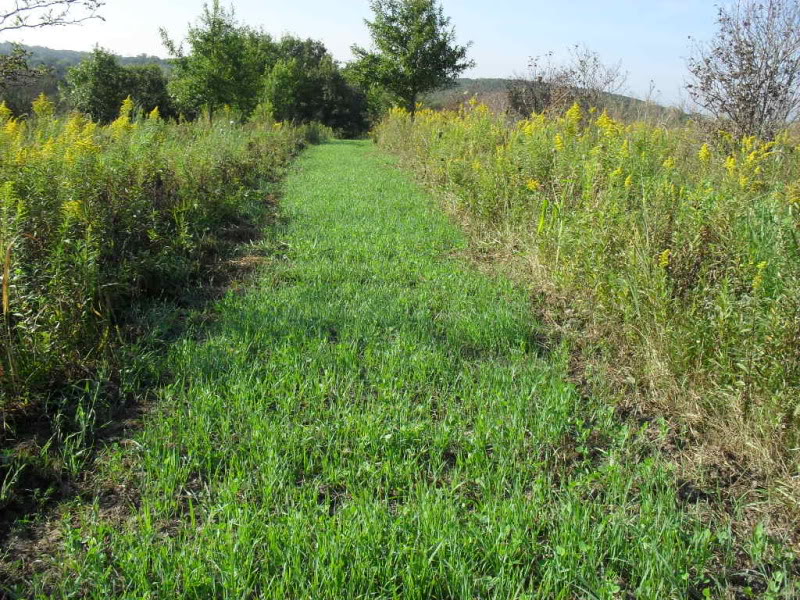
and the other with Winter Triticale and 4010 Field/forage peas
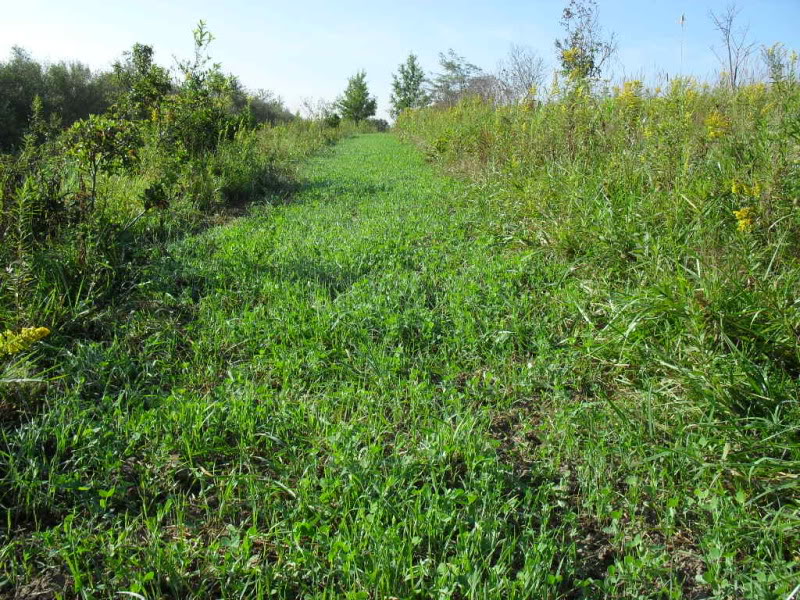
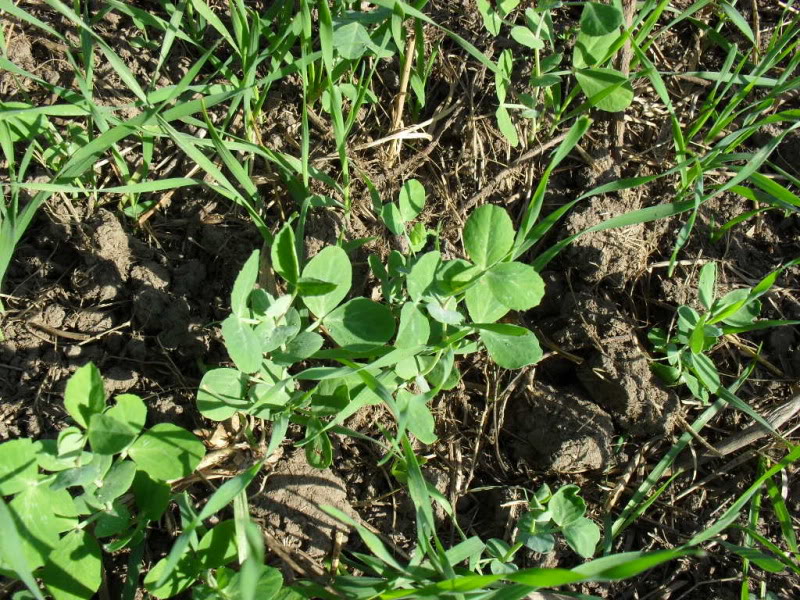
I'm headed out today to overseed some winter rye into heavily grazed brassicas to take advantage of the upcoming possiblity of rain. I'll continue to share progress and different scenarios that plotters face using a wide array of equipment or lak thereof...
This gives us two much needed oppurtunities...
1) To overseed winter rye into standing, soybeans, corn or heavily grazed brassicas right before a rain that will insure germination and quick growth.
2) This is perfect timing to topdress nitrogen if you have any fall crops that need it. If you tilled in plenty of N at planting, it's doubtful that you will need aditional N. Now is the time however to watch the weather closely and apply urea as close as possible to rainfall that hopefully exceed a 1/2" to push nitrogen into the soil.
Winter rye is amazing in that it is one of the most drought resistant cereals and rye can grow on almost ANY soils from sand to clay with no lime or fertilizer. That doesn't mean you can't or shouldn't improve your soils by soil testing and applying the appropriate ammendments but it does mean that if you have a last minute plot you want to stir up and plant something...winter rye is the best bet!
Here are some pics of my rye and peas at 2 weeks despite not having a drop of rain...

I lightly tilled in the larger seeds (winter rye, common oats, peas), cultipacked, sowed red clover and Groundhog Forage radish and re-cultipacked.
Because I put the larger seeds in the moisture zone of the soil, they are growing just fine even without rain.
I sowed two strips heavily and upped peas to nearly 100#'s per acre due to expected heavy deer traffic. I also added 150#'s of urea in these two test strips.


The two strips are in a tree planting, one with winter rye and Austrian Winter peas

and the other with Winter Triticale and 4010 Field/forage peas


I'm headed out today to overseed some winter rye into heavily grazed brassicas to take advantage of the upcoming possiblity of rain. I'll continue to share progress and different scenarios that plotters face using a wide array of equipment or lak thereof...
dbltree
Super Moderator
Most everyone here on IW already is aware that there are differences between field peas and AWP's from following the Field Pea thread but I just want to re-visit the subject here as well.
What is the difference between Austrian Winter Peas and Field/Forage Peas??
In reality I have found very little difference with the possible exception of winterhardiness in the AWP's, however I have found that to be a moot point because rarely do deer allow them to survive with or without cold weather.
Both have purple flowers and side by side it is impossible to tell them apart
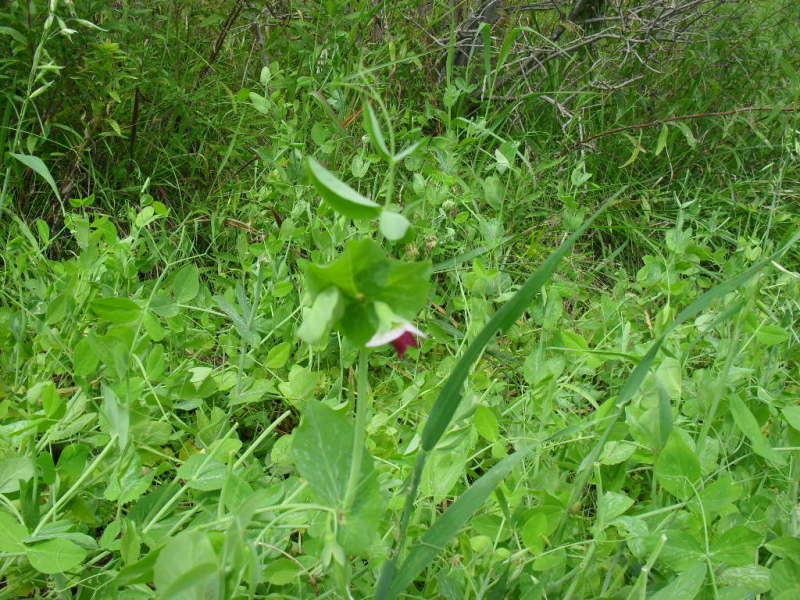
These are 4010 field peas at $22 a bag
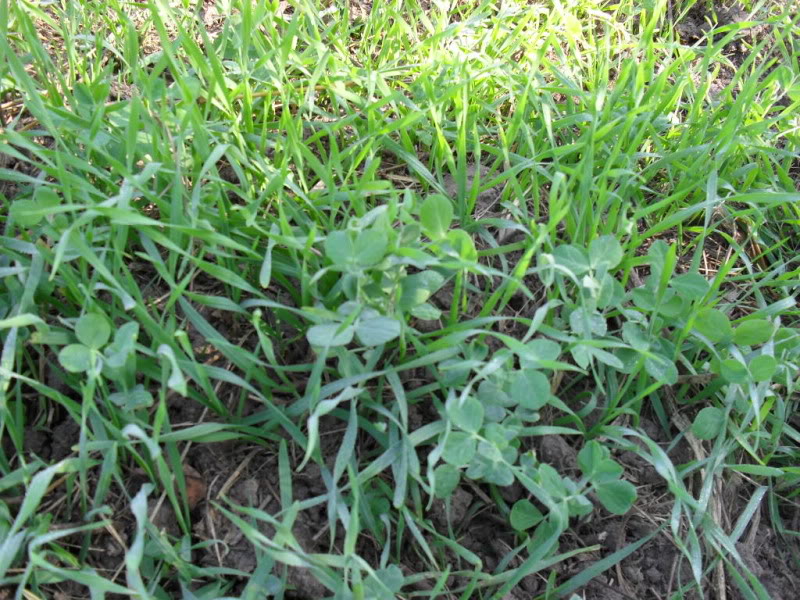
these are Austrian Winter peas at $45 a bag

Both planted the same day only feet apart with a mix of winter rye and oats, neither have had a drop of rain in 3 weeks now but seem no worse for wear.
Will one attract better, longer, differently then the other...time will tell...
What is the difference between Austrian Winter Peas and Field/Forage Peas??
Field Pea (Pisum sativum L.), a native of Southwest Asia, was among the first crops cultivated by man. Wild field pea can still be found in Afghanistan, Iran and Ethiopia
Austrian Winter Pea (Pisum sativum spp arvense) is a fall-seeded pea introduced from Austria to the Pacific Northwest in the 1930s.
In reality I have found very little difference with the possible exception of winterhardiness in the AWP's, however I have found that to be a moot point because rarely do deer allow them to survive with or without cold weather.
Both have purple flowers and side by side it is impossible to tell them apart

These are 4010 field peas at $22 a bag

these are Austrian Winter peas at $45 a bag

Both planted the same day only feet apart with a mix of winter rye and oats, neither have had a drop of rain in 3 weeks now but seem no worse for wear.
Will one attract better, longer, differently then the other...time will tell...
dbltree
Super Moderator
I've posted plenty of pics of rye and peas that have been either tilled in and then cultipacked or at least packed to cover.
What happens if you don't have a means of "packing"??
On one farm I had no choice but to till in the rye and peas and then spread the clover and forage radish seed on top and hope it rained.
After 3 weeks we finally got a decent rain today but these pics are from last week before the rain and the rye and peas come up just fine.
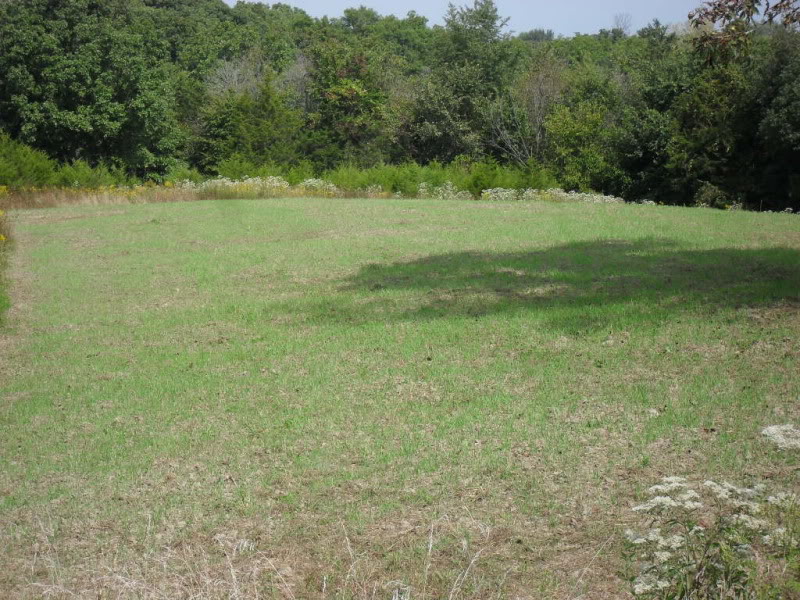
What doesn't germinate are the small seeds laying on top although generally they will just lay there until rain settles the soil around the seed.
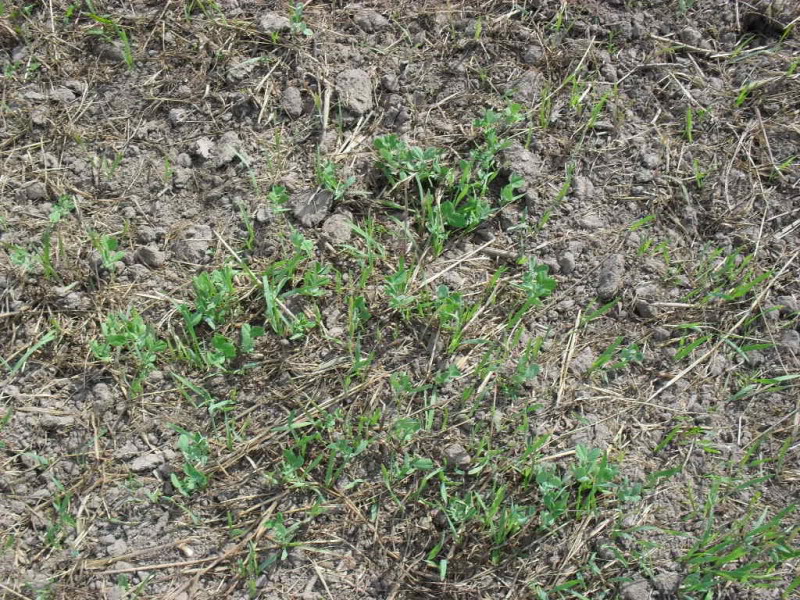
The peas like deeper planting depths so despite not having the soil firmed over them they came up fairly well
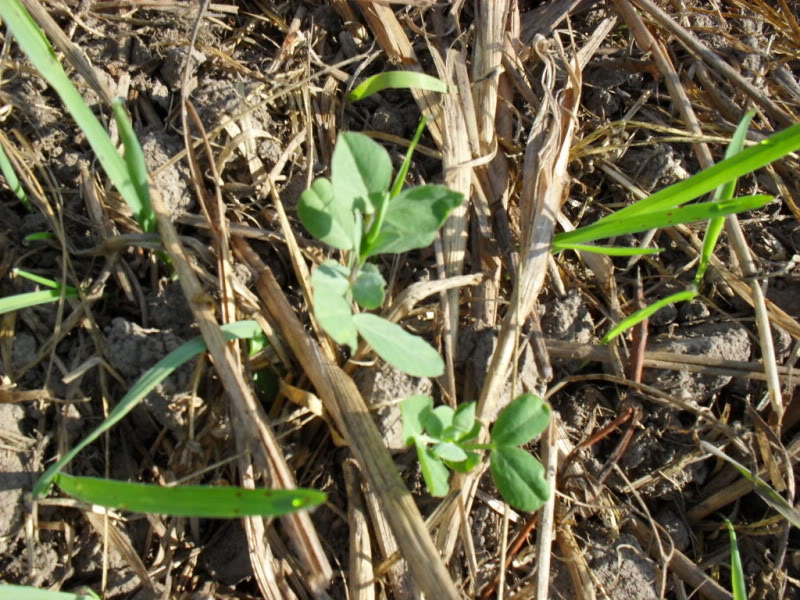
We'll check on these next week and see if the small seeds are coming up and compare growth with those that germinated quickly thanks to a cultipacker and a firm seedbed.
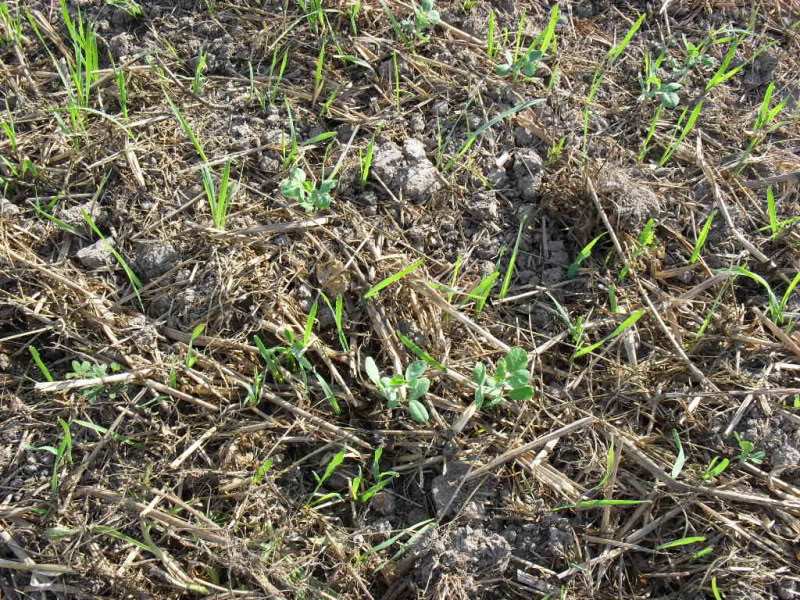
We'll also see if we can see the effects of adding nitrogen now that we have had rain and if overseeded rye seed has germinated on bare ground...
What happens if you don't have a means of "packing"??
On one farm I had no choice but to till in the rye and peas and then spread the clover and forage radish seed on top and hope it rained.
After 3 weeks we finally got a decent rain today but these pics are from last week before the rain and the rye and peas come up just fine.

What doesn't germinate are the small seeds laying on top although generally they will just lay there until rain settles the soil around the seed.

The peas like deeper planting depths so despite not having the soil firmed over them they came up fairly well

We'll check on these next week and see if the small seeds are coming up and compare growth with those that germinated quickly thanks to a cultipacker and a firm seedbed.

We'll also see if we can see the effects of adding nitrogen now that we have had rain and if overseeded rye seed has germinated on bare ground...
dbltree
Super Moderator
Winter Rye is just so versatile and easy to work with and it goes with somethings like peanut butter and jelly!
Establishing clover with winter rye is the IMO the absolute easiest and "bestest" way to not have to fight with weeds all summer! The rye acts as a nurse crop and then also helps supress weeds the following spring, even after being clipped since th allelopathic chemicals continue to exist in the root systems.
way to not have to fight with weeds all summer! The rye acts as a nurse crop and then also helps supress weeds the following spring, even after being clipped since th allelopathic chemicals continue to exist in the root systems.
The fall established clover will come on like gang busters in very early spring further suppressing weeds that would otherwise explode to life in a spring planting.
I sow 6#'s of white clover if I plan to leave the plot in clover long term or 12#'s or red clover if I plan to till down the plot for brassicas or another rye plot.
White clover will provide 25% CP and 80% TDN starting first thing in the spring and lasting until freezing fall weather...all for $30 an acre for seed. That translates to $6 a year if you maintain the stand for 5 years and purchase seed from a source such as Welter seed.
For most plotters white clover is very easy to maintain and nearly impossible for deer to decimate like they can with corn, soybeans, beets and brassicas. The drawback is that for colder areas like Iowa clovers are not suitable for late season attraction, and it is for that reason I plant brassicas, winter rye and peas or in larger fields, corn, beans and milo.
When I plant red clover it also provides 20% CP and 70% TDN all spring and summer until I till it under an take advantage of 130-200#'s of N fixed while growing and adding 2.5 tons of dry matter to my soils.
These are very very inexpensive ways/means of providing top quality, high yielding forage while also using less herbicide and expensive nitrogen fertilizers.
This is test plot in which 4 different white clovers are being tested on my farm, planted Sept 2 with winter rye that we'll follow thru into spring and see how they do.
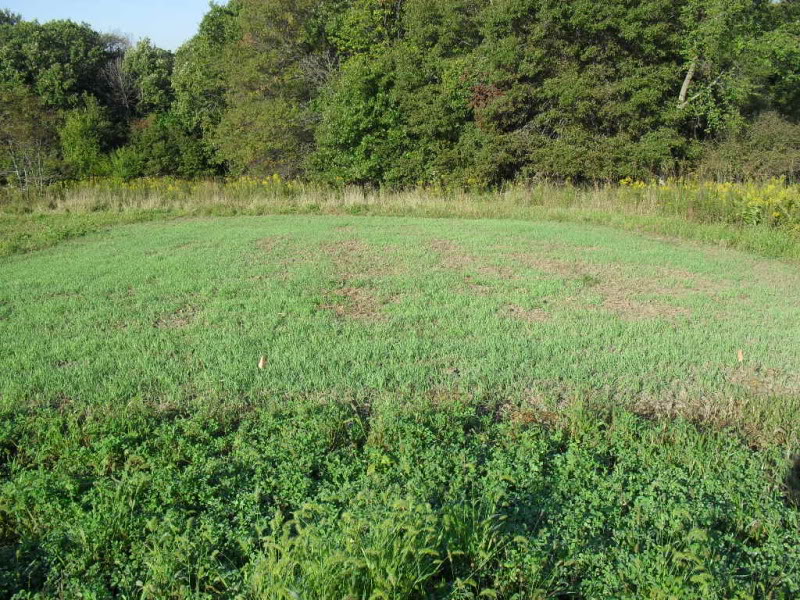
This is Alice white clover established in Sept 2008 with winter rye a year later...
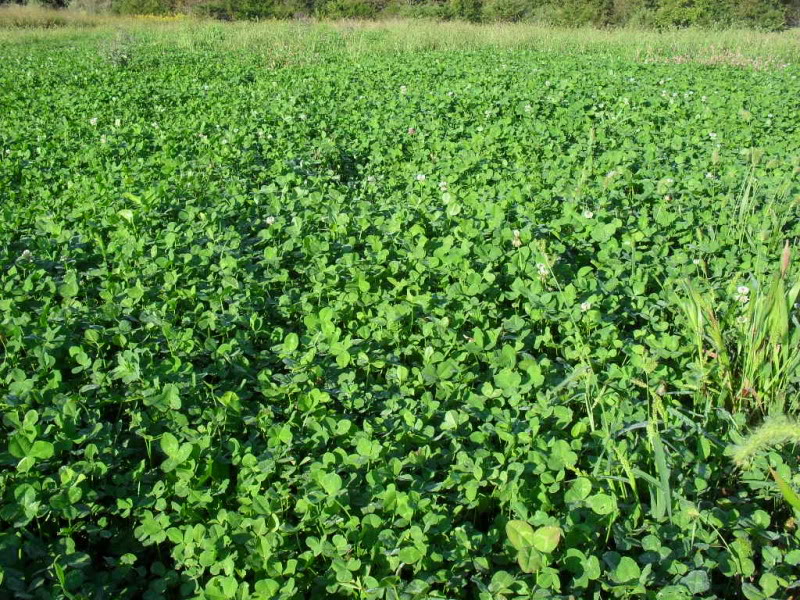
This is red clover (established the fall before with rye) in early summer after spraying the rye with glyphosate after it had already matured...didn't even phase the clover!
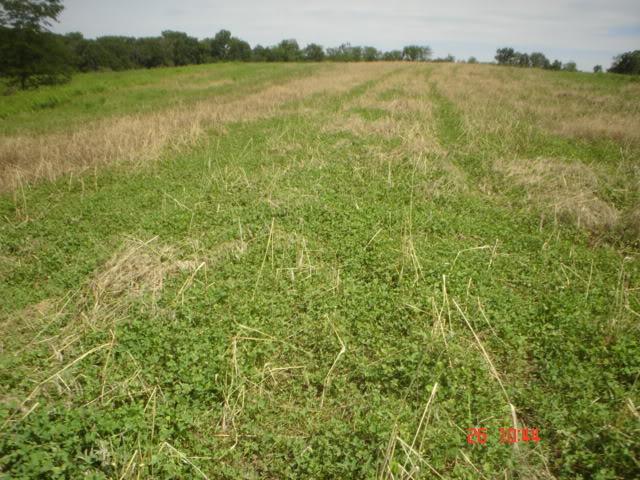
Anybody can sow and grow clover with rye assuming you have heavier soils (clover doesn't like sandy soils) and you soil test and make amendments to your PH and P&K as needed.
It's getting late to sow clover this year but if you hadn't thought of it, consider frost seeding late this winter to ave you messing around in wet spring weather...
Establishing clover with winter rye is the IMO the absolute easiest and "bestest"
The fall established clover will come on like gang busters in very early spring further suppressing weeds that would otherwise explode to life in a spring planting.
I sow 6#'s of white clover if I plan to leave the plot in clover long term or 12#'s or red clover if I plan to till down the plot for brassicas or another rye plot.
White clover will provide 25% CP and 80% TDN starting first thing in the spring and lasting until freezing fall weather...all for $30 an acre for seed. That translates to $6 a year if you maintain the stand for 5 years and purchase seed from a source such as Welter seed.
For most plotters white clover is very easy to maintain and nearly impossible for deer to decimate like they can with corn, soybeans, beets and brassicas. The drawback is that for colder areas like Iowa clovers are not suitable for late season attraction, and it is for that reason I plant brassicas, winter rye and peas or in larger fields, corn, beans and milo.
When I plant red clover it also provides 20% CP and 70% TDN all spring and summer until I till it under an take advantage of 130-200#'s of N fixed while growing and adding 2.5 tons of dry matter to my soils.
These are very very inexpensive ways/means of providing top quality, high yielding forage while also using less herbicide and expensive nitrogen fertilizers.
This is test plot in which 4 different white clovers are being tested on my farm, planted Sept 2 with winter rye that we'll follow thru into spring and see how they do.

This is Alice white clover established in Sept 2008 with winter rye a year later...

This is red clover (established the fall before with rye) in early summer after spraying the rye with glyphosate after it had already matured...didn't even phase the clover!

Anybody can sow and grow clover with rye assuming you have heavier soils (clover doesn't like sandy soils) and you soil test and make amendments to your PH and P&K as needed.
It's getting late to sow clover this year but if you hadn't thought of it, consider frost seeding late this winter to ave you messing around in wet spring weather...
dbltree
Super Moderator
What happens when you sow winter rye and there is no rain to germinate the seed?
It just lays there, sometimes for weeks until rains finally add moisture and the seed germinates. This plot the seed was broadcast on tilled soil but not tilled in before packing keeping the seed up and away from the sub surface moisture.
The seed layed there for 3 weeks , it rained and it then promptly came up...
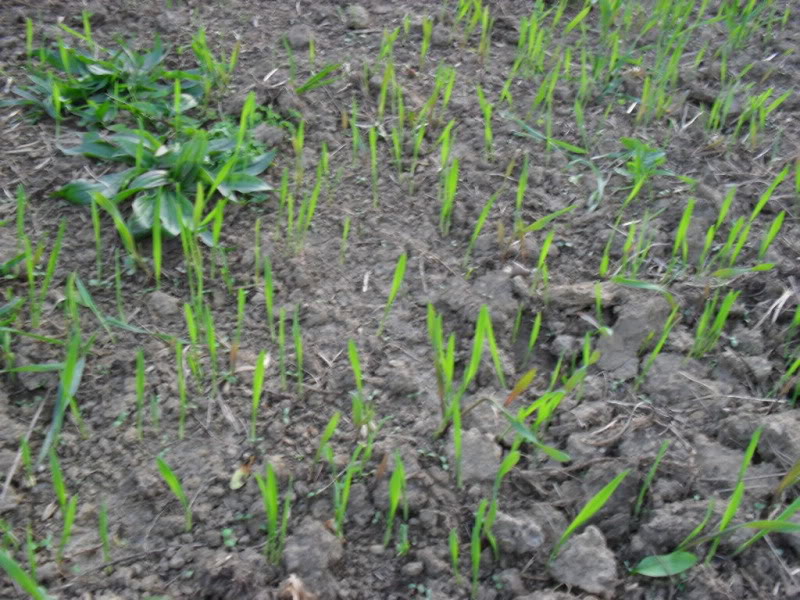
Only 10 feet away in the same plot in a slightly lower spot, the seed had enough moisture near the surface and it germinated right away.
Winter rye planted Sept 4th (same as the above pic) note the grazing...
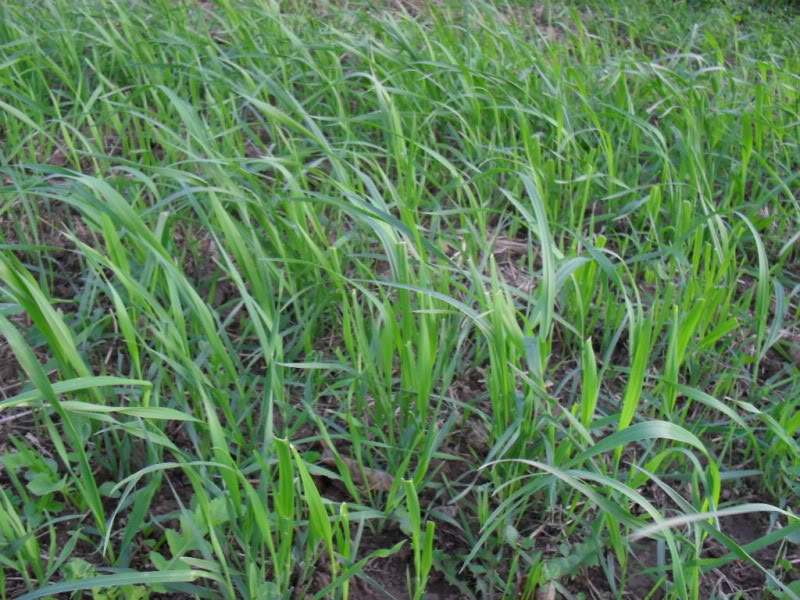
When do deer eat winter rye and how tall should it be to be attractive?
When rye gets 3-6" tall they will begin to graze it heavily unless another food source is more attractive(acorns, freshly combined corn etc). The height at which it becomes unattractive can vary, again depending on the availablity of other food sources but I would prefer it not get much above 8-10" and shorter is better in most cases.
They are hammering all of my plots on three different farms in two different counties here in Iowa despite being planted next to alfalfa, clover, soybeans, corn and brassicas.
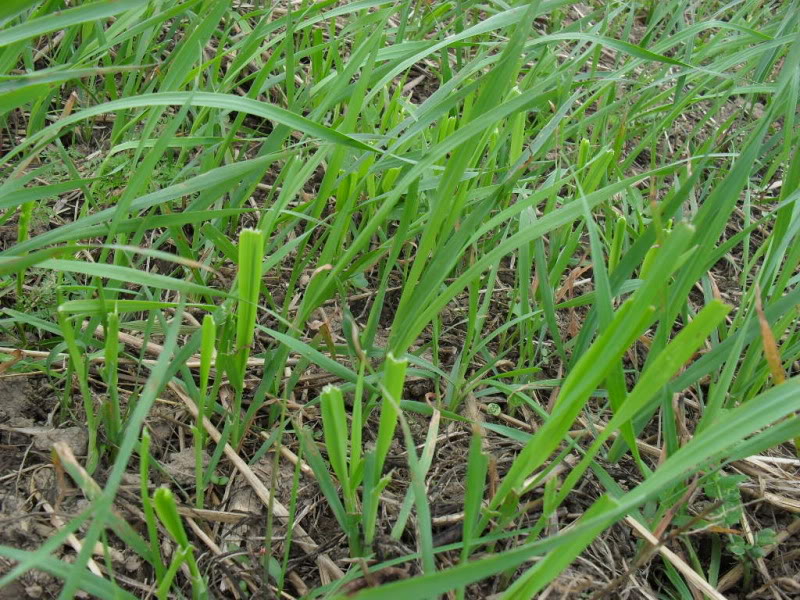
This is an example of pea growth after almost 30 days of growth, 3 weeks of which we had not a drop of rain.
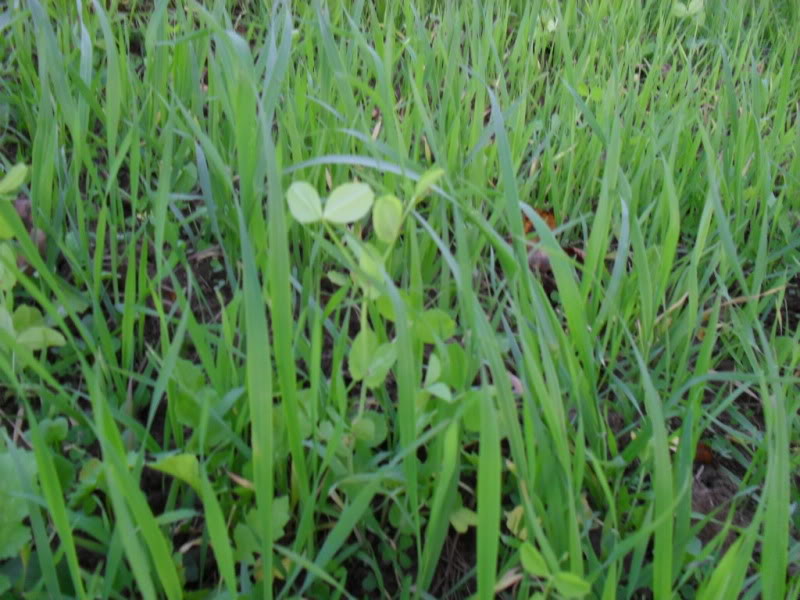
Several things can be noted from this, no rain doesn't = a lost stand regarding rye and one can see how overseeding into soybeans or corn will work just fine once you get rain. The seed will just lay there until it rains although birds and rodents will get some.
Lightly tilling/discing/dragging cereal grain seeds in before packing will insure that seeds are placed in the moisture zone and encourage rapid even germination.
Over seeding additonal rye at intervals thru out the fall can provide varying stages of growth even if seeded back into the same rye plot.
It just lays there, sometimes for weeks until rains finally add moisture and the seed germinates. This plot the seed was broadcast on tilled soil but not tilled in before packing keeping the seed up and away from the sub surface moisture.
The seed layed there for 3 weeks , it rained and it then promptly came up...

Only 10 feet away in the same plot in a slightly lower spot, the seed had enough moisture near the surface and it germinated right away.
Winter rye planted Sept 4th (same as the above pic) note the grazing...

When do deer eat winter rye and how tall should it be to be attractive?
When rye gets 3-6" tall they will begin to graze it heavily unless another food source is more attractive(acorns, freshly combined corn etc). The height at which it becomes unattractive can vary, again depending on the availablity of other food sources but I would prefer it not get much above 8-10" and shorter is better in most cases.
They are hammering all of my plots on three different farms in two different counties here in Iowa despite being planted next to alfalfa, clover, soybeans, corn and brassicas.

This is an example of pea growth after almost 30 days of growth, 3 weeks of which we had not a drop of rain.

Several things can be noted from this, no rain doesn't = a lost stand regarding rye and one can see how overseeding into soybeans or corn will work just fine once you get rain. The seed will just lay there until it rains although birds and rodents will get some.
Lightly tilling/discing/dragging cereal grain seeds in before packing will insure that seeds are placed in the moisture zone and encourage rapid even germination.
Over seeding additonal rye at intervals thru out the fall can provide varying stages of growth even if seeded back into the same rye plot.
dbltree
Super Moderator
Do you need to add lime and fertilizer to a winter rye planting?
No...rye will grow on almost any soil and PH levels, however it is a great time to start correcting soil nutrient problems for the next crops by applying lime, P&K per soil testing.
Should I use nitrogen tilled in at planting?
That depends on how intense you feel grazing will be and time of planting. Applying nitrogen can cause more harm then good by encouraging rapid growth that will leave winter rye (or any cereal) to tall, stemmy and unpalatable by late hunting season.
Use 40-80#'s of actual nitrogen per acre only if...
1) You expect heavy grazing and need to encourage growth to keep up with it
2) You plant late and want the rye to grow rapidly to catch up before cold weather
I fertilized with 200#'s of urea on the right, 100#'s in the middle and zero on the left in this pic and you can see that it is greener on the right.
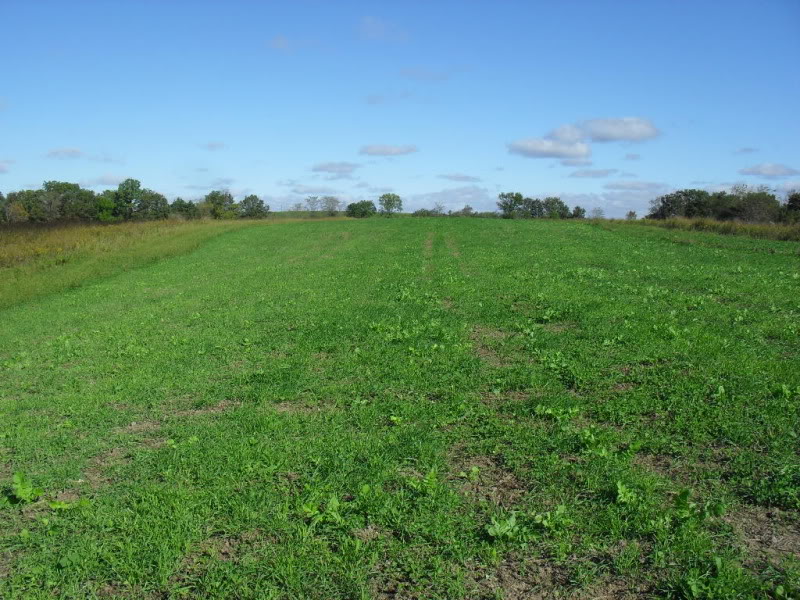
Will deer prefer areas I fertilize?
On three different farms...deer eat the rye with and without nitrogen equally
No nitrogen....
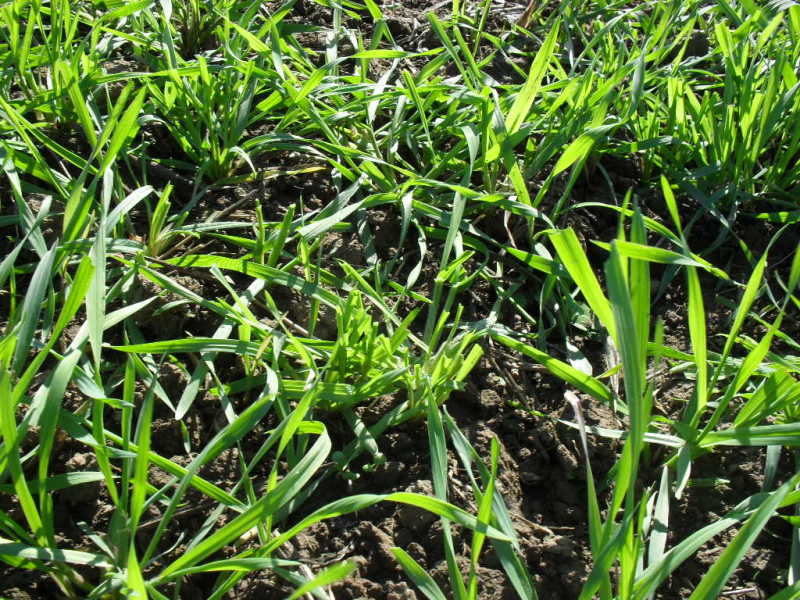
200#'s of urea applied at planting
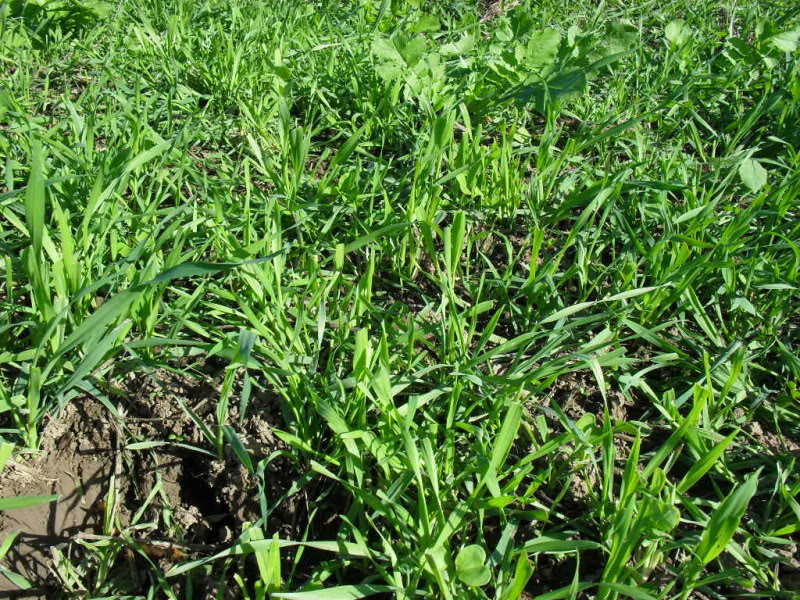
Should I topdress additional nitrogen to "sweeten" the rye?
Topdressing will not make the rye any "sweeter" then adding nitrogen at planting and because rye (or any fall grains) are in the ground a short time before cold weather it makes little sense to add additional nitrogen.
Top dressing nitrogen is risky when using urea, without rain it will quickly be lost and all forms of nitrogen need rain to push it to root depth so if you need N the least risk option is to apply it at planting time.
If you find that your rye is being hammered hard and you need addtional growth then apply nitrogen just before a rain but adding it is not going to attract more/bigger/better deer then already feed there.
How late can I plant rye?
Rye will germinate at 34 dgrees and grow at 38 degrees but a minimum of 3 weeks of growing weather is usually required to have enough growth for the rye to be attractive to deer. Weather of course plays a huge influence on the actual growth of winter rye but generally by this time one has little to lose by sowing rye.
I planted 2 more acres on September 29th and expect to have very good growth yet this fall.
This is 30 days of winter rye and pea growth after 3 weeks with not a drop of rain.

Can I really just broadcast winter rye onto untilled soil and actually have it germinate and grow??
Absoutely!
Two things are required...soil/seed contact and rain! Without rain the seed will just lay there until it gets moisture but once it does rain (or the soil is already moist) the seed will quickly germinate and grow.
I over seeded this rye about 10 days ago into some heavily grazed brassicas...
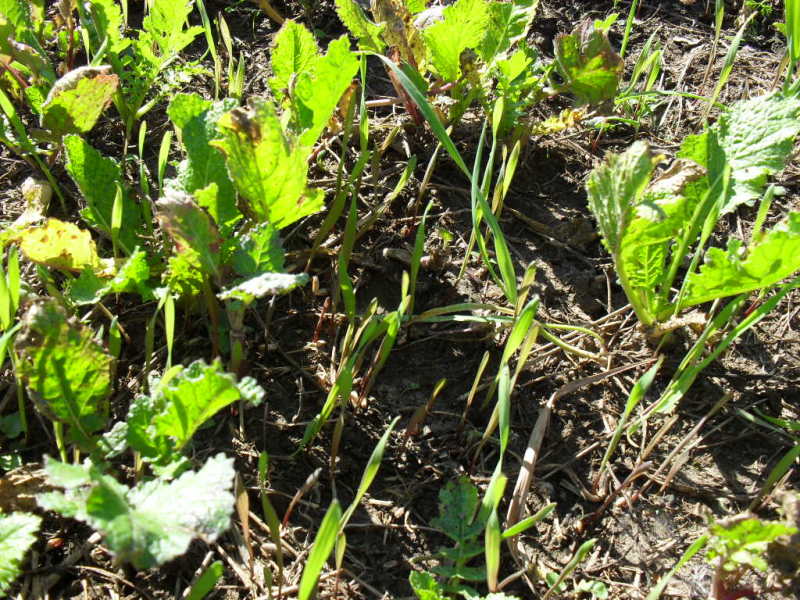
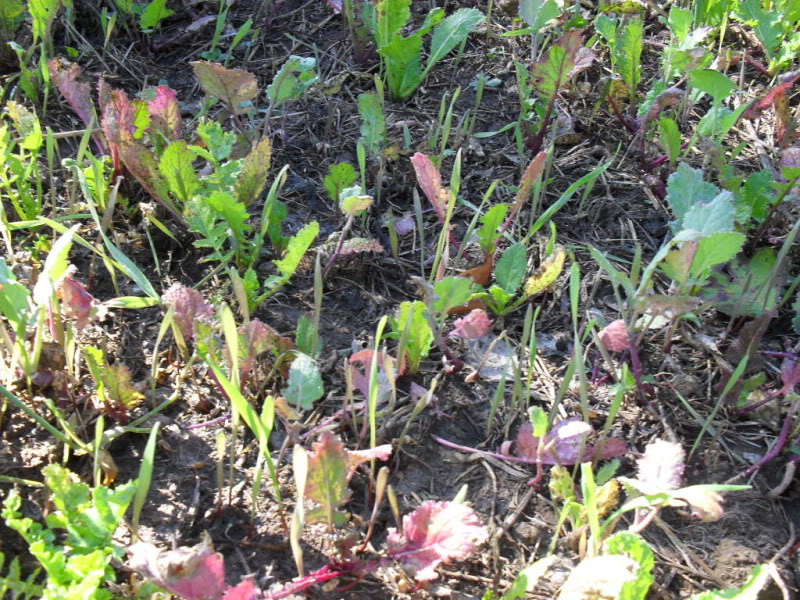
Into some field peas
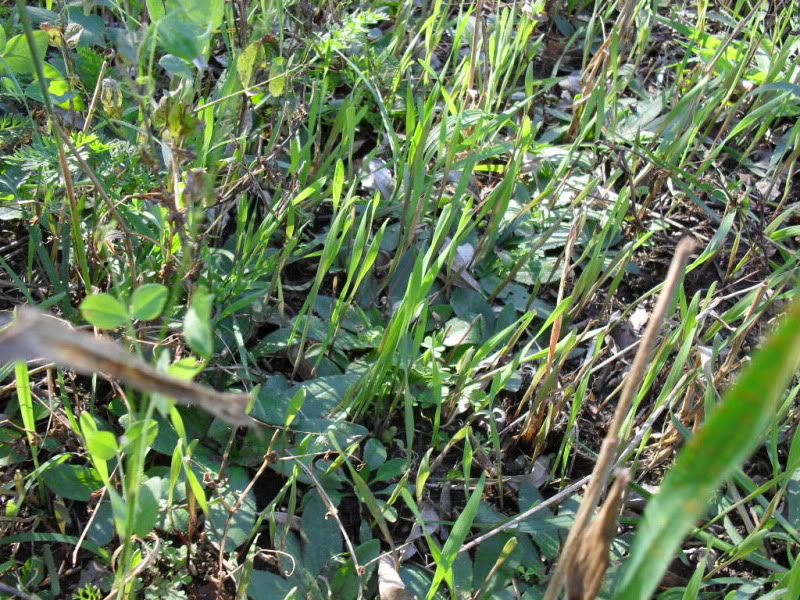
and just bare soil
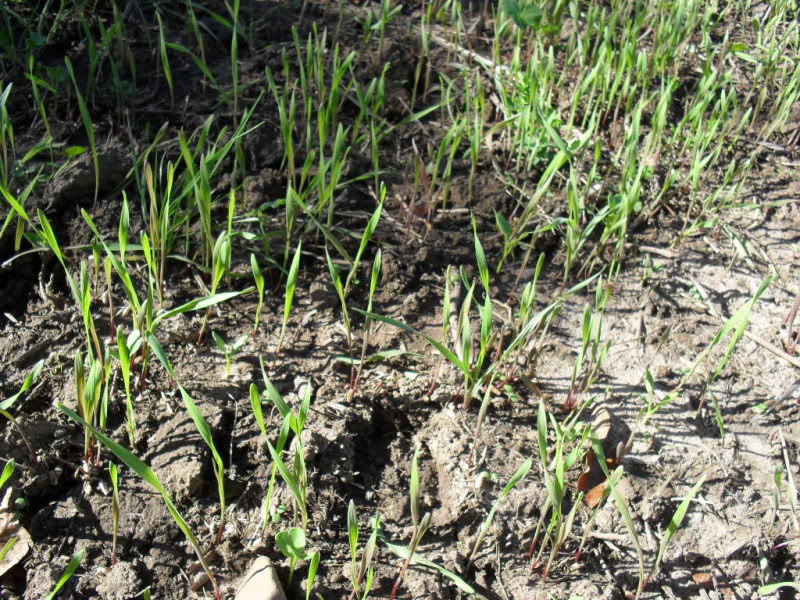
Nothing could be easier then overseeding winter rye into standing crops such as soybeans, corn, thin or heavily grazed brassicas, beets, peas, milo...the list is endless!
It will not work to overseed rye into brassicas or soybeans that are tall and have a heavy canopy. Soys will eventually drop leaves but brassicas will remain standing until to late for the rye to grow.
Overseed winter rye at 100-150#'s per acre as close to a rain as possible although it will just lay there until it does rain.
Red clover can be added to the rye to overseed into standing soybeans as well...
No...rye will grow on almost any soil and PH levels, however it is a great time to start correcting soil nutrient problems for the next crops by applying lime, P&K per soil testing.
Should I use nitrogen tilled in at planting?
That depends on how intense you feel grazing will be and time of planting. Applying nitrogen can cause more harm then good by encouraging rapid growth that will leave winter rye (or any cereal) to tall, stemmy and unpalatable by late hunting season.
Use 40-80#'s of actual nitrogen per acre only if...
1) You expect heavy grazing and need to encourage growth to keep up with it
2) You plant late and want the rye to grow rapidly to catch up before cold weather
I fertilized with 200#'s of urea on the right, 100#'s in the middle and zero on the left in this pic and you can see that it is greener on the right.

Will deer prefer areas I fertilize?
On three different farms...deer eat the rye with and without nitrogen equally
No nitrogen....

200#'s of urea applied at planting

Should I topdress additional nitrogen to "sweeten" the rye?
Topdressing will not make the rye any "sweeter" then adding nitrogen at planting and because rye (or any fall grains) are in the ground a short time before cold weather it makes little sense to add additional nitrogen.
Top dressing nitrogen is risky when using urea, without rain it will quickly be lost and all forms of nitrogen need rain to push it to root depth so if you need N the least risk option is to apply it at planting time.
If you find that your rye is being hammered hard and you need addtional growth then apply nitrogen just before a rain but adding it is not going to attract more/bigger/better deer then already feed there.
How late can I plant rye?
Rye will germinate at 34 dgrees and grow at 38 degrees but a minimum of 3 weeks of growing weather is usually required to have enough growth for the rye to be attractive to deer. Weather of course plays a huge influence on the actual growth of winter rye but generally by this time one has little to lose by sowing rye.
I planted 2 more acres on September 29th and expect to have very good growth yet this fall.
This is 30 days of winter rye and pea growth after 3 weeks with not a drop of rain.

Can I really just broadcast winter rye onto untilled soil and actually have it germinate and grow??
Absoutely!
Two things are required...soil/seed contact and rain! Without rain the seed will just lay there until it gets moisture but once it does rain (or the soil is already moist) the seed will quickly germinate and grow.
I over seeded this rye about 10 days ago into some heavily grazed brassicas...


Into some field peas

and just bare soil

Nothing could be easier then overseeding winter rye into standing crops such as soybeans, corn, thin or heavily grazed brassicas, beets, peas, milo...the list is endless!
It will not work to overseed rye into brassicas or soybeans that are tall and have a heavy canopy. Soys will eventually drop leaves but brassicas will remain standing until to late for the rye to grow.
Overseed winter rye at 100-150#'s per acre as close to a rain as possible although it will just lay there until it does rain.
Red clover can be added to the rye to overseed into standing soybeans as well...
- Deleted by N/A
- Deleted by N/A
HannibalBowhunter
New Member
Paul,
Just wanted to thank you for all the advice. Here are a couple of pictures from today. I overseeded my beans 12 days ago and they are already 3-4 inches tall! There is early browsing going on as well!


Just wanted to thank you for all the advice. Here are a couple of pictures from today. I overseeded my beans 12 days ago and they are already 3-4 inches tall! There is early browsing going on as well!

